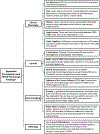Update on the Clinical, Radiographic, and Neurobehavioral Manifestations in FXTAS and FMR1 Premutation Carriers
- PMID: 27287737
- PMCID: PMC7608648
- DOI: 10.1007/s12311-016-0799-4
Update on the Clinical, Radiographic, and Neurobehavioral Manifestations in FXTAS and FMR1 Premutation Carriers
Abstract
Fragile X-associated tremor/ataxia syndrome (FXTAS) is a progressive neurodegenerative disorder caused by a repeat expansion in the fragile X mental retardation 1 (FMR1) gene. The disorder is characterized by kinetic tremor and cerebellar ataxia, shows age-dependent penetrance, and occurs more frequently in men. This paper summarizes the key emerging issues in FXTAS as presented at the Second International Conference on the FMR1 Premutation: Basic Mechanisms & Clinical Involvement in 2015. The topics discussed include phenotype-genotype relationships, neurobehavioral function, and updates on FXTAS genetics and imaging.
Keywords: Cognition; FMR1 genetics; FMR1 premutation; Fragile X-associated tremor/ataxia syndrome (FXTAS); Neuroimaging.
Conflict of interest statement
Figures


References
-
- Sherman S. Premature ovarian failure in the fragile X syndrome. Am J Med Genet. 2000;97:189–94. - PubMed
-
- Hagerman RJ, Leehey M, Heinrichs W, Tassone F, Wilson R, Hills J, et al. Intention tremor, parkinsonism, and generalized brain atrophy in male carriers of fragile X. Neurology. 2001;57:127–30. - PubMed
Publication types
MeSH terms
Substances
Supplementary concepts
Grants and funding
LinkOut - more resources
Full Text Sources
Other Literature Sources
Medical

